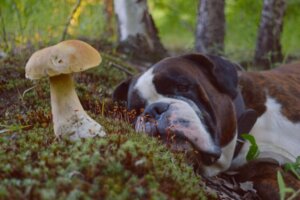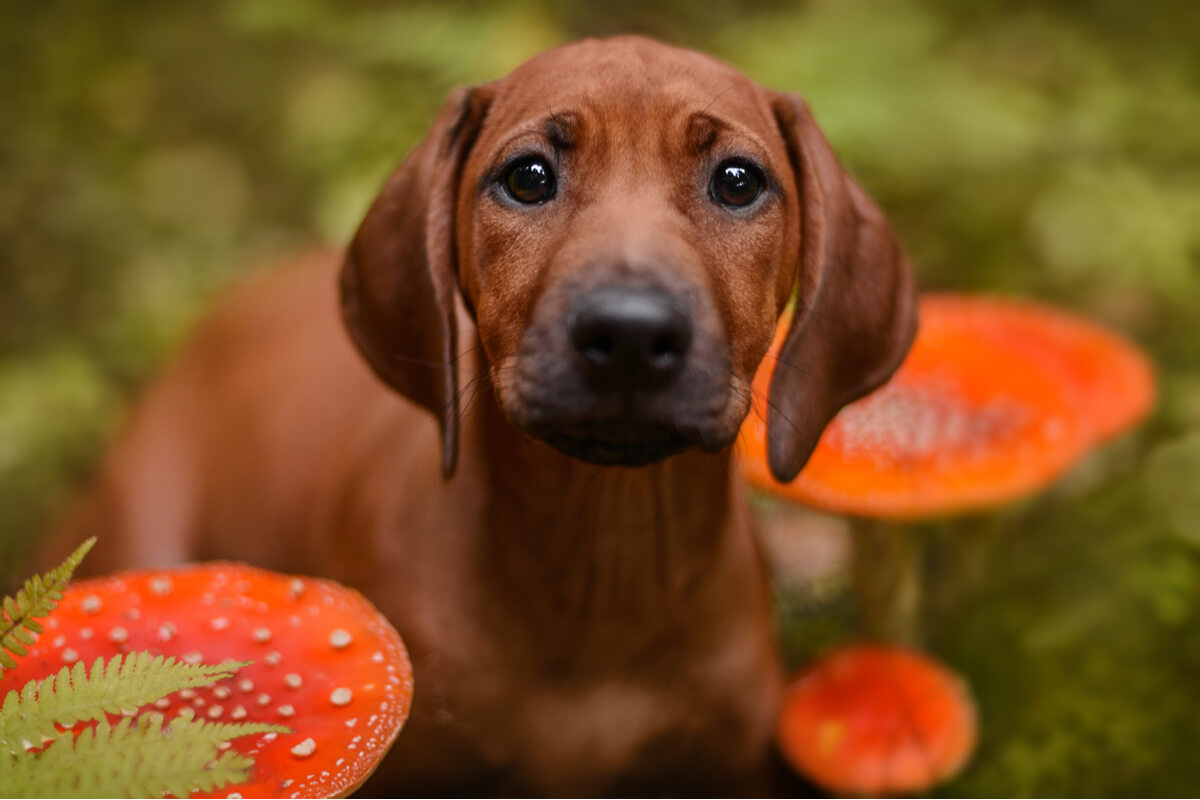7 Tips to Follow if Your Dog Eats a Mushroom or Toadstool

Field trips in search of mushrooms and toadstools are one of the best days out for mycology enthusiasts. Many of them also take their dog with them, as it’s also a fun day for pets. But what happens if the dog eats a mushroom or toadstool in the process?
It’s common knowledge that some mushrooms and many toadstools are highly toxic and can even kill the animal. In addition, many of them resemble their edible version, making it difficult to differentiate them. For this reason, in this article, we’ll bring you all the advice you need to cope should this mishap occur. Don’t miss this article, as your dog’s life could be at stake.
Signs of poisoning in dogs
Before bringing you our tips, the first thing you need to know about are the most typical signs of poisoning in dogs.
- Vomiting
- Diarrhea
- Excessive salivation
- Weakness
- Yellowing of the mucous membranes (jaundice)
- Convulsions
- Loss of consciousness
- Uncoordinated movements
If you observe that your dog suddenly shows these signs, take them immediately to a veterinarian. This is an emergency, because depending on the amount of poison the dog has ingested, their life could be in danger.

7 tips to follow if your dog eats a mushroom or toadstool
Even the best-behaved dog is tempted to eat whatever they find on the ground. That’s why you may find yourself in the situation we’re talking about, or you may not even know what they have eaten. If this is the case, follow the recommendations below.
1. Learn to identify the symptoms
If your dog shows signs of intoxication as described in the previous section, don’t think twice – take them to the nearest veterinarian. There, they’ll pump their stomach and stabilize them if they’re seriously ill. In cases of poisoning, every second counts.
2. If you see the mushroom or toadstool they have eaten, take a sample to the vet
This will be very useful for the vet to know what effects the mushroom could have on the dog’s body. Even if you know the species, you should be aware that some mushrooms aren’t poisonous for humans, but are for dogs. This is the case with the saffron milk cap (Lactarius deliciosus), which are one of the main reasons for veterinary emergencies during the mushroom picking season.
The dog can also become inoxicated by licking the mushroom basket or the gloves used to pick mushrooms.
3. Don’t resort to home remedies
Although home remedies are useful for certain ailments, don’t think that these can be used if a dog eats a mushroom. This poisoning is a cause for urgency and using temporary measures could worsen the situation, putting the animal’s life in jeopardy.
4. Don’t try and get your dog to vomit
While you may think that making the dog vomit will prevent the poisoning from progressing, this is a technique that should only be carried out under veterinary control. If you do it on your own, you may leave some of the mushroom or toadstool in the stomach, running the risk of the animal getting aspiration pneumonia.
5. Carry a mushroom guide with you
Carrying a mycological guide with you will be a great help. Although it’s often believed that dangerous mushrooms are those with bright and striking colors, this isn’t always the case.
An example of this is Amanita phalloides, also known as green hemlock. This mushroom looks completely harmless and tastes very good. However, it is one of the most dangerous mushrooms on Earth and, as if that weren’t enough, the symptoms of poisoning aren’t noticed until 48 hours after ingestion.
6. Find out about mushrooms that are toxic for your dog
Now that you have a guide on mushrooms and fungi, it’s a good idea to look check which are poisonous to your dog. Checking out information on this subject isn’t only useful for you, but will give you an idea of the dangers that surround your animal when you go out to collect mushrooms.
7. Use prevention
If you want to prevent your dog from eating something dangerous when outside, there are several measures you can take. Here are some useful ones:
- Train your dog not to pick up anything from the ground: Some dogs have an easier time than others when it comes to this learning process, but if yours drops the mushroom they’re eating on your command, it can make the difference between a serious intoxication and a minor one.
- Muzzle them when you go walking: This is a good option for the most gluttonous dogs. There are many comfortable muzzles that allow the dog to breathe, pant and sniff without any problem, but they prevent them from picking up anything from the ground.
- Feed your dog before the walk: Although it isn’t advisable to exercise right after eating, it’s a good way to reduce their desire to eat.

Excursions with your dog are always moments to treasure, but you should never forget the dangers that exist in the countryside. These risks should be known about and prevented, because, if not, the most idyllic outing could turn into an emergency visit to the vet.
Field trips in search of mushrooms and toadstools are one of the best days out for mycology enthusiasts. Many of them also take their dog with them, as it’s also a fun day for pets. But what happens if the dog eats a mushroom or toadstool in the process?
It’s common knowledge that some mushrooms and many toadstools are highly toxic and can even kill the animal. In addition, many of them resemble their edible version, making it difficult to differentiate them. For this reason, in this article, we’ll bring you all the advice you need to cope should this mishap occur. Don’t miss this article, as your dog’s life could be at stake.
Signs of poisoning in dogs
Before bringing you our tips, the first thing you need to know about are the most typical signs of poisoning in dogs.
- Vomiting
- Diarrhea
- Excessive salivation
- Weakness
- Yellowing of the mucous membranes (jaundice)
- Convulsions
- Loss of consciousness
- Uncoordinated movements
If you observe that your dog suddenly shows these signs, take them immediately to a veterinarian. This is an emergency, because depending on the amount of poison the dog has ingested, their life could be in danger.

7 tips to follow if your dog eats a mushroom or toadstool
Even the best-behaved dog is tempted to eat whatever they find on the ground. That’s why you may find yourself in the situation we’re talking about, or you may not even know what they have eaten. If this is the case, follow the recommendations below.
1. Learn to identify the symptoms
If your dog shows signs of intoxication as described in the previous section, don’t think twice – take them to the nearest veterinarian. There, they’ll pump their stomach and stabilize them if they’re seriously ill. In cases of poisoning, every second counts.
2. If you see the mushroom or toadstool they have eaten, take a sample to the vet
This will be very useful for the vet to know what effects the mushroom could have on the dog’s body. Even if you know the species, you should be aware that some mushrooms aren’t poisonous for humans, but are for dogs. This is the case with the saffron milk cap (Lactarius deliciosus), which are one of the main reasons for veterinary emergencies during the mushroom picking season.
The dog can also become inoxicated by licking the mushroom basket or the gloves used to pick mushrooms.
3. Don’t resort to home remedies
Although home remedies are useful for certain ailments, don’t think that these can be used if a dog eats a mushroom. This poisoning is a cause for urgency and using temporary measures could worsen the situation, putting the animal’s life in jeopardy.
4. Don’t try and get your dog to vomit
While you may think that making the dog vomit will prevent the poisoning from progressing, this is a technique that should only be carried out under veterinary control. If you do it on your own, you may leave some of the mushroom or toadstool in the stomach, running the risk of the animal getting aspiration pneumonia.
5. Carry a mushroom guide with you
Carrying a mycological guide with you will be a great help. Although it’s often believed that dangerous mushrooms are those with bright and striking colors, this isn’t always the case.
An example of this is Amanita phalloides, also known as green hemlock. This mushroom looks completely harmless and tastes very good. However, it is one of the most dangerous mushrooms on Earth and, as if that weren’t enough, the symptoms of poisoning aren’t noticed until 48 hours after ingestion.
6. Find out about mushrooms that are toxic for your dog
Now that you have a guide on mushrooms and fungi, it’s a good idea to look check which are poisonous to your dog. Checking out information on this subject isn’t only useful for you, but will give you an idea of the dangers that surround your animal when you go out to collect mushrooms.
7. Use prevention
If you want to prevent your dog from eating something dangerous when outside, there are several measures you can take. Here are some useful ones:
- Train your dog not to pick up anything from the ground: Some dogs have an easier time than others when it comes to this learning process, but if yours drops the mushroom they’re eating on your command, it can make the difference between a serious intoxication and a minor one.
- Muzzle them when you go walking: This is a good option for the most gluttonous dogs. There are many comfortable muzzles that allow the dog to breathe, pant and sniff without any problem, but they prevent them from picking up anything from the ground.
- Feed your dog before the walk: Although it isn’t advisable to exercise right after eating, it’s a good way to reduce their desire to eat.

Excursions with your dog are always moments to treasure, but you should never forget the dangers that exist in the countryside. These risks should be known about and prevented, because, if not, the most idyllic outing could turn into an emergency visit to the vet.
All cited sources were thoroughly reviewed by our team to ensure their quality, reliability, currency, and validity. The bibliography of this article was considered reliable and of academic or scientific accuracy.
- Franco, R. R. (2006). Intoxicaciones por hongos en animales domésticos. Recursos Rurais, 29.
- Garcia, J., Costa, V. M., Carvalho, A., Baptista, P., de Pinho, P. G., de Lourdes Bastos, M., & Carvalho, F. (2015). Amanita phalloides poisoning: Mechanisms of toxicity and treatment. Food and chemical toxicology, 86, 41-55.
- Puschner, B., & Wegenast, C. (2012). Mushroom poisoning cases in dogs and cats: diagnosis and treatment of hepatotoxic, neurotoxic, gastroenterotoxic, nephrotoxic, and muscarinic mushrooms. Veterinary Clinics: Small Animal Practice, 42(2), 375-387.
This text is provided for informational purposes only and does not replace consultation with a professional. If in doubt, consult your specialist.








